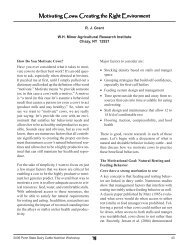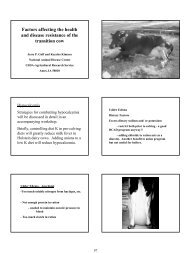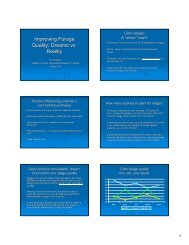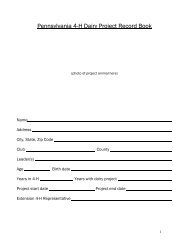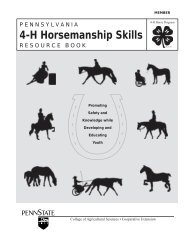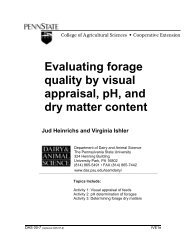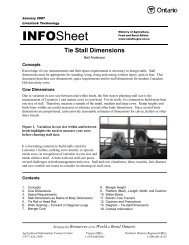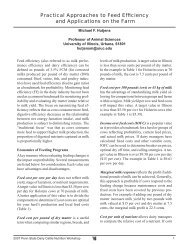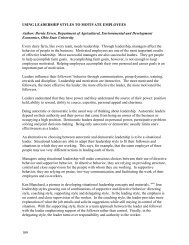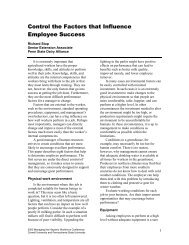1 DEALING WITH PROBLEM SILAGES: FOCUS ON CLOSTRIDIUM ...
1 DEALING WITH PROBLEM SILAGES: FOCUS ON CLOSTRIDIUM ...
1 DEALING WITH PROBLEM SILAGES: FOCUS ON CLOSTRIDIUM ...
You also want an ePaper? Increase the reach of your titles
YUMPU automatically turns print PDFs into web optimized ePapers that Google loves.
<strong>DEALING</strong> <strong>WITH</strong> <strong>PROBLEM</strong> <strong>SILAGES</strong>: <strong>FOCUS</strong> <strong>ON</strong> <strong>CLOSTRIDIUM</strong><br />
W. C. Stone and L. E. Chase<br />
Department of Animal Science<br />
Cornell University<br />
The dairy industry realizes the importance of forage quality, and puts a lot of effort<br />
into producing a feed that is highly digestible, properly preserved, and palatable.<br />
Unfortunately, the end result is not always what was intended. Environmental conditions<br />
and delayed harvest timing can lower silage digestibility. Excessive growth of molds and<br />
yeasts, along with inappropriate silage fermentations, can result in silage with poor<br />
aerobic stability and decreased palatability. This paper will focus on clostridial silage<br />
fermentations. The causes of these problem fermentations, methods to decrease their<br />
risk, consequences they may cause on the dairy, and strategies to handle this type of<br />
silage will be discussed.<br />
CAUSES AND CHARACTERISTICS OF CLOSTRIDIAL FERMENTATI<strong>ON</strong>S<br />
Silage that goes through a clostridial fermentation stinks! Clostridial fermentations<br />
are so malodorous because of the high levels of butyric acid, amines (e.g. putrescine<br />
and cadavarine), and ammonia that typify these fermentations. Clostridia silage is<br />
typically wet (< 32% DM) and often olive or greenish in color.<br />
Clostridia are naturally present in the soil. Although their numbers are very low on<br />
standing forage, inoculation occurs during mechanical handling of the crop. The<br />
bacteria prefer growth conditions that are wet (< 30% DM) and at a higher pH, although<br />
growth can still occur at slightly higher DM and down to a pH of 4.2. They typically take<br />
over the fermentation when the lactobacilli have used up available substrate, the silage<br />
is wet, and the pH is still above ~4.8 (McDonald, 1991). Although the clostridia genus<br />
contains over 60 species, it appears that only about seven play a predominant role in<br />
silage fermentation (Gibson, 1965). Clostridium tyrobutyricum is the species most<br />
frequently isolated from silage (McDonald, 1991). Botulism is caused by ingestion of the<br />
botulinum toxin, produced by Clostridium botulinum. Botulism toxicosis has been<br />
reviewed elsewhere (Whitlock and Williams, 1999), and will not be discussed here.<br />
Clostridia have been classified as either lacate or amino acid fermenters. Lactate<br />
fermenting clostridia bacteria ferment any remaining sugars and lactic acid, increasing<br />
silage pH and producing butyric acid as a fermentative end-product. Amino acid<br />
fermenting clostridia deaminate or decarboxylate amino acids, resulting in the<br />
production of ammonia, amines, CO2, and a variety of acids (McDonald, 1991). The pH<br />
of a clostridial fermentation increases, since butyrate is a much weaker acid than<br />
lactate, and since it takes two moles of lactate to produce one mole of butyrate.<br />
Kemble (1956) inoculated ryegrass silage with clostridia or lactobacilli. Ammonia<br />
levels increased markedly in the silage inoculated with clostridia, with the largest<br />
increase occurring between 21 and 57 days post-ensiling. The amount of ammonia<br />
1
present in silages has been used to estimate the degree of proteolytic clostridial activity<br />
since it had been thought that little ammonia was produced by other silage microbes.<br />
However, large amounts of ammonia can also be produced by enterobacteria<br />
(McDonald, 1991). A guideline used in the evaluations of silage fermentations is that<br />
ammonia nitrogen should be less than 10% of the total nitrogen (Mahanna and Chase,<br />
2003).<br />
The importance of low DM silage in the evolvement of a clostridial fermentation can<br />
be seen from the data of Ward (2000). Fermentation profiles from approximately 1200<br />
alfalfa and 400 grass silages indicate that butyrate and ammonia nitrogen levels<br />
increased, and lactate decreased, as silage DM decreased (Figures 1 and 2). These<br />
data corroborate that compiled by Pitt (1990), which indicate that alfalfa typically has<br />
inadequate levels of sugar to complete the fermentation at DM less than 34%, while<br />
grasses, due to their lower natural buffering capacity and higher sugar levels, may still<br />
have a complete fermentation at DM as low as 17%. Evidence of a clostridial<br />
fermentation (increased butyrate and ammonia, decreased lactate) in grasses begins at<br />
the 28-32% DM range, and becomes more pronounced as DM further decreases<br />
(Figure 2).<br />
The amino acid composition of silage is dramatically altered in a clostridial<br />
fermentation. Mead (1971) grew three species of clostridia (Cl. bifermentans, Cl.<br />
sporogenes, and Cl. tetanomorphum) in pure culture to evaluate their relative effects on<br />
various amino acids. Both the direction and degree of change in amino acid levels<br />
varied with the species of clostridia. Their results indicated that the amino acid<br />
fermenting clostridia will certainly change the amino acid composition of silage, the<br />
degree and direction of the alteration varying with the species of clostridium<br />
predominating in the fermentation.<br />
ANIMAL TRIALS <strong>WITH</strong> CLOSTRIDIAL <strong>SILAGES</strong><br />
OR THEIR FERMENTATI<strong>ON</strong> END-PRODUCTS<br />
Thomas et al. (1961) fed heifers silage of varying dry matters. They found that intake<br />
was linearly and positively related to the dry matter content of the silage. The authors<br />
concluded that the dry matter content of the silage at ensiling, and the resultant<br />
fermentation process, was very important in determining the rate of silage consumption.<br />
Since then many trials have evaluated animal responses when silage juice, or a<br />
purified component of something found in silage juice, was orally intubated or ruminally<br />
infused. Most of these trials used sheep, steers, or heifers; few have used highproducing<br />
dairy cows. The silage juice infusion generally has a greater negative effect<br />
on intake than the infusion of purified or a laboratory prepared mix of silage juice<br />
components.<br />
Clancy et al. (1977) treated alfalfa at ensiling with formic acid. Pressed silage juice<br />
from the control and formic acid treated silages, and a synthetic juice with many of the<br />
2
% of DM<br />
6.00<br />
5.00<br />
4.00<br />
3.00<br />
2.00<br />
1.00<br />
0.00<br />
52<br />
Alfalfa silage DM range<br />
NH3 -N<br />
Butyrate<br />
Lactate<br />
Acetate<br />
pH<br />
Figure 1. The relationship between alfalfa silage DM and the resultant<br />
fermentation (Ward, 2000).<br />
% of DM<br />
6.00<br />
5.00<br />
4.00<br />
3.00<br />
2.00<br />
1.00<br />
0.00<br />
44<br />
Grass silage DM range<br />
NH3 -N<br />
Butyrate<br />
Lactate<br />
Acetate<br />
pH<br />
Figure 2. The relationship between grass silage DM and the resultant<br />
fermentation (Ward, 2000).<br />
3
same characteristics as the silage juice, was ruminally infused into sheep. Intakes were<br />
depressed for a longer time period in sheep infused with the control silage juice than<br />
with that obtained from formic acid treated silage. Intakes were depressed less when<br />
sheep were infused with the synthetic juice. The authors concluded that other factors,<br />
such as the amines, may have resulted in the greater intake depressing effects seen<br />
with the control silage juice.<br />
Barry et al. (1978a) preserved fresh-cut lucerne with formic acid or formaldehyde,<br />
and then fed the silage to sheep in a nitrogen balance trial. Voluntary intake decreased<br />
linearly with increasing degradation of silage proteins and the formation of acetic acid<br />
and ammonia. They concluded that the control of proteolytic clostridial activity was more<br />
critical than the control of plant respiration following ensiling in avoiding restrictions to<br />
intake and nitrogen retention. In a companion paper, Barry et al. (1978b) evaluated the<br />
influence of silage amino acid composition on the nutritive value of the silage. They<br />
reported that intake and nitrogen utilization were related to the net changes in amino<br />
acids involved with decarboxylation reactions, while those involved with deamination<br />
reactions appeared to be of much less importance. Formaldehyde treatment of fresh<br />
forage reduces protein degradation in the silo, thus dramatically reducing the potential<br />
development of biogenic amines (Barry et al., 1978a).<br />
Each of the amines listed in Table 1 are formed from decarboxylation reactions. For<br />
example, lysine is catabolized to form cadaverine and CO2, while arginine forms<br />
putrescine and CO2. Lysine and arginine can also be deaminated, resulting in the<br />
formation of acetate, butyrate and ammonia (from lysine), and ornithine, ammonia, and<br />
CO2 (from arginine) (MacDonald et al. 1991).<br />
Lingass and Tveit (1992) ruminally intubated cows with butyric acid (200 g split into<br />
2 doses given 2 h apart) for three consecutive days. Blood acetoacetate levels<br />
significantly increased in both early and late lactation cows. Acetoacetate levels rose<br />
higher, and remained elevated for a longer period of time, in early lactation as<br />
compared to later lactation cows. It would require the consumption of 2.85 kg DM of 7%<br />
butyric acid haylage (the level found in the silages described in Table 1) to equal this<br />
quantity of infused butyrate.<br />
Lingass and Tveit (1992) also ruminally intubated cows with putrescine (100 g in 1<br />
dose) for three consecutive days (Figure 3). The putrescine infusate resulted in<br />
significant decreases in feed intake and milk yield, with marked individual variation in<br />
response. For example, one of the cows consumed very little feed on the last<br />
experimental day, although she recovered completely after the experimental period. The<br />
quantity of putrescine infused was much greater than cows would normally consume,<br />
even if the feeds had undergone a clostridial fermentation. For example, it would take<br />
approximately 100 kg DM of the silage described in Table 1 to provide 100 g of<br />
putrescine, or approximately 20 kg DM of the silage to provide 100 g of all of the<br />
measured amines. Lingass and Tveit (1992) recognized this, noting that the effect of the<br />
amines when fed in combination and for a longer time period, as when feeding silage,<br />
may well be different than when infusing only one amine for a relatively short time<br />
4
period. Support for this observation is seen in Tveit et al. (1992), who fed cows haylage<br />
that had undergone a clostridial fermentation. They found that the ruminal<br />
concentrations of amines increased throughout the seven day experimental period. The<br />
authors speculated that the amine degradation capacity of rumen microflora was<br />
reduced over time, leading to an increase in ruminal amine concentrations and thus an<br />
increased risk to the “possible toxic effects” of the amines.<br />
Milk, kg/d<br />
35<br />
30<br />
25<br />
20<br />
15<br />
0 1 2<br />
Day of experiment<br />
3 4<br />
Butyrate<br />
Putrescine<br />
Control<br />
Figure 3. The effect of ruminal intubation of butyrate, putrescine, or no treatment on milk<br />
production (Lingaas and Tveit, 1992). Infusions occurred on days 1-3.<br />
Anderson and Lundstrom (1985) fed early lactation Swedish Red and White cows<br />
varying amounts a grass silage containing approximately 2% butyric acid. They reported<br />
a significantly negative correlation between ketone bodies and milk yield, and a trend for<br />
ketone values to increase when butyrate intake exceeded 100 g. Milk yield averaged<br />
about 25 kg during the eight week trial.<br />
Tveit and Lingaas (1992) found that while the concentration of amines from eleven<br />
samples collected from two silos were highly correlated (~.7), the correlation between<br />
the amines and butyrate was only about .2. These results seem logical, since the<br />
clostridia involved with the fermentation could have been butyrate or amino acid<br />
fermenters. The weak correlation between the amines and butyrate could explain the<br />
variability in performance when animals are fed clostridial silages. Several commercial<br />
laboratories measure silage VFA levels, while there are very few labs that measure the<br />
amines. Additionally, it currently costs approximately $20 for a VFA analysis, while the<br />
amine analysis costs in excess of $100. Largely because of these reasons, feeding<br />
5
ecommendations for clostridial silages have sometimes been made based on an<br />
estimated level of butyric acid intake (Anderson and Lundstrom, 1985). Since the<br />
amines have had more pronounced deleterious effects on performance than butyrate,<br />
and the two may not be strongly correlated, it could be problematic to base feeding<br />
recommendations of clostridial silages on the predicted level of butyric acid intake.<br />
However, the critical levels of an amine, or combination of amines, or amines and<br />
butyrate, for causing problems in a given species and in a given class of animal are<br />
unknown. Thus, the safest approach is to try to minimize exposure of clostridial silage to<br />
classes of animal that may be at a higher risk of developing health problems (e.g.<br />
recently fresh and high DMI cows).<br />
MANAGEMENT OF CLOSTRIDIAL SILAGE<br />
Since intake can be reduced and ketone levels elevated when clostridial silage is<br />
fed, it makes sense to try to avoid exposure of transition and high DMI animals to this<br />
silage.<br />
Haylage was collected from the upper, middle, and lower thirds of nine bunker silos<br />
in New York. The silage was analyzed for VFA and other typical forage components<br />
(Stone et al., 2003). Butyrate levels varied between and within silos (Figure 4). Some of<br />
the silo regions could really cause some problems, especially if the feeder obtained all<br />
of the silage for the prefresh or fresh groups from a region that had underwent a<br />
clostridial fermentation. Nutritionists and producers should constantly evaluate bunker<br />
silos for layers and regions that have gone through a bad fermentation. These regions<br />
can typically be identified by critically using our visual and olfactory senses. Objective<br />
VFA measurements can be readily obtained from commercial feed laboratories. Ideally,<br />
silage defacers would be used to remove silage from these regions, either discarding it<br />
or feeding to a less susceptible class of animal (e.g. bred heifers).<br />
Two samples of wet, greenish-brown, foul-smelling silage were used in an<br />
experiment to evaluate the effect of aeration and mixing on the levels of VFA and<br />
amines. Silage from both bunkers was spread out on the floor in layers 2.5-5.0 cm<br />
deep. The silage was allowed to aerate, and samples were collected at the start of the<br />
study, and 2, 4, 8, and 26 hours later. Additionally, each of the silages was mixed in a<br />
portable cement mixer, with samples collected after 2 and 4 hours of mixing. The<br />
temperature averaged approximately 21° C throughout aeration time where the floor<br />
samples were located, and 26° C during operation of the cement mixer. The VFA were<br />
measured by Dairy One (Ithaca, NY) using a gas chromatograph, while the amines<br />
were measured by the toxicology lab at Mississippi State University using the procedure<br />
of Tamim et al. (2002).<br />
Both silages were characteristic of a clostridial fermentation – low DM, with high<br />
levels of butyrate, the amines, and ammonia, and low levels of lactate (Tables 1 and 2).<br />
The alfalfa silage that was spread out on the floor dried out much more than the other<br />
samples, simply because there was less of this silage and the layer was only about 2.5<br />
cm deep. Interestingly, the reduction in ammonia was also the greatest in this treatment<br />
6
Hlge % But/Isobut<br />
8<br />
7<br />
6<br />
5<br />
4<br />
3<br />
2<br />
1<br />
0<br />
Top<br />
Middle<br />
Bottom<br />
1 2 3 4 5 6 7 8 9<br />
Bunker Silo<br />
Figure 4. Levels of butyric and isobutyric acid (% DM) in bunker silos of<br />
haylage at nine New York dairies. Samples were collected with a<br />
backhoe from the upper, middle, and bottom thirds of most silos.<br />
(Table 1). Crude protein levels in feed dried for four hours at 60° C were about ten<br />
percentage points lower than the measured CP in the wet samples. This represents the<br />
large quantity of ammonia nitrogen volatized during the drying process. Since feed<br />
proteins typically average about 16% nitrogen, CP levels are obtained by multiplying the<br />
nitrogen level by 6.25. Ammonia is 82% nitrogen. Thus, the volatized nitrogen should<br />
technically be multiplied by a factor of 1.2, resulting in an increase in CP in the wet<br />
samples of about two percentage points over the dry CP measurements. Butyrate levels<br />
were significantly reduced with aeration, with the greatest reduction occurring in the<br />
alfalfa silage that dried out the most. The decrease in butyrate in the other samples was<br />
significant, although the slight decrease in these samples may not have clinical or<br />
practical relevance. Mixing did not result in any significant loss of VFA or ammonia.<br />
Neither aeration or mixing affected amine levels if all results were included in the<br />
statistical analysis. However, results from the alfalfa haylage that was placed in the<br />
cement mixer were inconsistent with the other sample results; the amine levels in this<br />
sample increased during mixing time. Dr. Lloyd Bennett, who ran the amine analyses<br />
and co-developed the analytical procedure, states that the relative standard deviation of<br />
the procedure is small (approximately 10%), but that variations in amine levels<br />
throughout the silo can be large (personal communication). Despite the samples being<br />
well-mixed, it is likely that the results from this treatment were a sampling artifact. If<br />
these results are excluded from the statistical analysis, then amine concentrations<br />
decreased over time (Table 2). In conclusion from this study, aeration appears to<br />
7
Table 1. The effect of aeration and mixing on VFA and ammonia-N levels a .<br />
Hour DM (b)<br />
NH3 Nitrogen as<br />
% of Total N<br />
pH Lactate Acetate Propionate<br />
(c)<br />
Alfalfa Silage - Floor<br />
Butyrate<br />
(d)<br />
reduce butyrate and amine concentrations, the level of reduction probably being<br />
correlated to the length of time the samples are aerated. Drying can further help to<br />
reduce butyrate and ammonia levels.<br />
PREVENTI<strong>ON</strong> OF CLOSTRIDIAL FERMENTATI<strong>ON</strong>S<br />
Total VFA CP, DM<br />
CP, AF<br />
(e)<br />
0 25.9 54.0 6.2 0.1 3.7 1.3 7.6 13.3 19.0 29.2<br />
2 27.2 56.7 6.2 0.1 3.7 1.4 7.7 13.2 18.4 29.9<br />
4 30.2 52.0 6.3 0.0 3.9 1.4 7.5 13.2 19.6 26.8<br />
8 35.7 49.0 6.5 0.1 3.8 1.4 7.2 12.9 20.0 28.1<br />
26 68.4 27.2 6.4 0.1 2.7 0.9 4.3 8.1 18.1<br />
Alfalfa Silage - Cement Mixer<br />
0 25.9 54.0 6.2 0.1 3.7 1.3 7.6 13.3 19.0 29.2<br />
2 28.1 53.0 6.3 0.0 3.5 1.3 7.5 12.8 19.1 28.8<br />
4 31.7 54.6 6.4 0.1 3.7 1.3 7.2 12.8 18.0 24.9<br />
Grass Silage - Floor<br />
0 23.7 96.0 6.1 0.1 7.4 1.7 7.3 17.1 13.7 26.1<br />
2 24.5 85.2 6.1 0.1 7.2 1.6 7.1 16.5 14.3 26.0<br />
4 25.6 99.8 6.2 0.1 7.8 1.7 7.5 17.5 13.9 25.9<br />
8 29.4 88.2 6.2 0.1 6.6 1.5 6.5 15.1 13.6 25.7<br />
26 33.9 84.7 6.4 0.0 6.2 1.4 5.8 13.8 12.9 23.1<br />
Grass Silage - Cement Mixer<br />
0 23.7 96.0 6.1 0.1 7.4 1.7 7.3 17.1 13.7 26.1<br />
2 24.0 96.0 6.2 0.1 7.1 1.6 7.1 16.5 13.4 26.1<br />
4 24.8 98.6 6.3 0.1 7.1 1.6 7.1 16.5 13.1 27.4<br />
Unless noted, results are on a DM basis.<br />
a<br />
Samples were allowed to aerate by either spreading them out on the floor or mixing in a cement mixer.<br />
b<br />
DM increased with aeration (P < .01)<br />
c<br />
Propionate tended to decrease with aeration (P = .07).<br />
d<br />
Butyrate decreased with aeration (P < .0001).<br />
e<br />
As fed CP levels tended to decrease with aeration (P = .06).<br />
The primary means to reduce the risk of a clostridial fermentation is to harvest<br />
haylage at DM above 34%. Increasing sugar levels at ensiling and promoting a rapid<br />
decrease in silage pH will also minimize the risk.<br />
Alfalfa and grass will dry out more quickly, and will have higher sugar levels at<br />
ensiling, if windrows are simply made wider. Wider windrows increase the crop’s<br />
surface area that is exposed to sun and air, resulting in substantial reductions in<br />
required drying times. This is critical in New York, where the number of consecutively<br />
sunny days in May and June is often very few. Some producers have begun to replace<br />
their existing harvesting equipment with newer models that are more amenable to wider<br />
windrows. Others have purchased smaller haybines (e.g. 14’ versus 18’) so that less<br />
material is in a windrow.<br />
8
Table 2. The effect of aeration and mixing on amine concentrations a .<br />
Hour DM<br />
Tryptamine<br />
ppm<br />
Phenethylamine<br />
ppm<br />
Putrescine<br />
ppm<br />
Alfalfa Silage - Floor<br />
Contamination of haylage with soil should be minimized, since it harbors clostridium<br />
and other unfavorable silage bacteria (McDonald et al., 1991).<br />
Management techniques (e.g. aggressive packing) and additives (e.g. lactobacillus<br />
inoculant) that aid in a rapid reduction in silage pH should also help to minimize the risk<br />
of a clostridial fermentation, since these bacteria prefer to grow at a higher pH.<br />
C<strong>ON</strong>CLUSI<strong>ON</strong><br />
Cadaverine<br />
ppm<br />
Histamine<br />
ppm<br />
Tyramine<br />
ppm<br />
0 25.9 467.3 1245.2 1074.7 1725.1 207.1 897.2<br />
2 27.2 439.5 1472.5 1321.2 2197.7 113.0 1543.9<br />
4 30.2 449.7 1348.7 1037.5 1602.4 183.8 982.1<br />
8 35.7 377.0 1198.6 1041.7 1656.9 167.2 862.7<br />
26 68.4 317.7 847.5 680.2 1111.0 133.7 622.8<br />
Alfalfa Silage - cement mixer<br />
0 25.9 467.3 1245.2 1074.7 1725.1 207.1 897.2<br />
2 28.1 525.1 1363.0 1189.7 1920.5 152.6 971.6<br />
4 31.7 645.6 1508.5 1183.1 2100.6 181.1 1208.8<br />
Grass Silage - Floor<br />
0 23.7 397.7 751.2 913.2 1825.7 108.5 1210.5<br />
2 24.5 324.8 667.0 733.8 1369.0 105.0 1032.2<br />
4 25.6 338.8 714.9 677.8 1552.6 133.6 780.2<br />
8 29.4 415.0 828.3 794.3 1639.0 123.6 1153.8<br />
26 33.9 313.7 644.6 650.9 1273.4 94.6 722.5<br />
Grass Silage - Cement Mixer<br />
0 23.7 397.7 751.2 913.2 1825.7 108.5 1210.5<br />
2 24.0 172.9 482.2 497.4 940.4 71.7 63.6<br />
4 24.8 38.5 383.0 331.2 643.7 52.3 385.5<br />
bc Significance, P =<br />
0.02 0.07 0.04 0.03 0.06 0.07<br />
Results are on a DM basis.<br />
a<br />
Samples were allowed to aerate by either spreading them out on the floor or mixing in a cement mixer.<br />
b<br />
Aeration time did not affect amine concentrations when all treatments were included.<br />
c<br />
Amine concentrations were reduced at the noted significance level if results from the alfalfa silage - cement mixer<br />
treatment were excluded.<br />
Silage that has underwent a clostridial fermentation can reduce intake and increase<br />
blood ketone levels. The main management approach to minimize the risk of a<br />
clostridial fermentation is to harvest haylage at DM above 34%. Nutritionists and<br />
feeders should regularly inspect haylage for evidence of a clostridial fermentation.<br />
Regions of poor haylage within the bunker should be directed away from transition and<br />
high DMI cows. Aeration can aid in decreasing butyrate, ammonia, and amine levels<br />
typically found in clostridial silage.<br />
9
REFERENCES<br />
Andersson, L. and K. Lundstrom. 1985. Effect of feeding silage with high butyric acid<br />
content on ketone body formation and milk yield in postparturient dairy cows.<br />
Zentralbl. Veterinaermed. Reihe A 32:15-23.<br />
Barry, T. N., J. E. Cook and R. J. Wilkins. 1978a. The influence of formic acid and<br />
formaldehyde additives and type of harvesting machine on the utilization of<br />
nitrogen in lucerne silages. 1. The voluntary intake and nitrogen retention of<br />
young sheep consuming the silages with and without intraperitoneal supplements<br />
of DL-methionine. J. agric. Sci., Camb., 91:701-715.<br />
Barry, T. N., J. E. Cook and R. J. Wilkins. 1978b. The influence of formic acid and<br />
formaldehyde additives and type of harvesting machine on the utilization of<br />
nitrogen in lucerne silages. 2. Changes in amino-acid composition during ensiling<br />
and their influence on nutritive value. J. agric. Sci., Camb., 91:717-725.<br />
Clancy, M., P. J. Wangsness, and B. R. Baumgardt. 1977. Effect of silage extract on<br />
voluntary intake, rumen fluid consitutents, and rumen motility. J. Dairy Sci.<br />
60:580-590.<br />
Gibson, T. 1965. Clostridia in silage. J. appl. Bact. 28:56-62.<br />
Kemble, A. R. 1956. Studies on the nitrogen metabolism of the ensilage process. J. Sci.<br />
Food Agric. 7:125-130.<br />
Lingaas, F. and B. Tveit. 1992. Etiology of acetonemia in Norwegian cattle. 2. Effect of<br />
butyric acid, valeric acid, and putrescine. J. Dairy Sci. 75:2433-2439.<br />
Mahanna, B. and L. E. Chase. 2003. Practical applications and solutions to silage<br />
problems. Pages 855-895 in Silage Science and Technology.<br />
McDonald, P, N. Henderson, and S. Heron. 1991. The biochemistry of silage, 2 nd<br />
edition. Chalcombe Publications, United Kingdom.<br />
Mead, G. C. 1971. The amino acid-fermenting clostridia. J. gen. Microbiol. 67:47-56.<br />
Pitt, R. E. 1990. Silage and hay preservation. NRAES. Ithaca, NY.<br />
Stone, W. C., L. E. Chase, and T. L. Batchelder. 2003. Corn silage and haylage<br />
variability within bunker silos. J. Dairy Sci. 86(Suppl. 1:168. (Abstr.)<br />
Tamim, N.M., L. W. Bennett, T. A. Shellem, and J. A. Doerr. 2002. High-performance<br />
liquid chromatographic determination of biogenic amines in poultry carcasses. J.<br />
Agric. Food Chem. 50:5012-5015.<br />
Thomas, J. W., L. A. Moore, M. Okamoto, and J. F. Sykes. 1961. A study of factors<br />
affecting rate of intake of heifers fed silage. J. Dairy Sci. 44:1471-1483.<br />
Tveit, B., F. Lingaas, M. Svendsen, and O. Sjaastad. 1992. Etiology of acetonemia in<br />
Norwegian cattle. 1. Effect of ketogenic silage, season, energy level, and genetic<br />
factors. J. Dairy Sci. 75:2421-2432.<br />
Ward, R. T. 2000. Fermentation analysis: use and interpretation. Proc. Tri-State Dairy<br />
Nutr. Conf., Fort Wayne, IN 117-136.<br />
Whitlock, R. H. and J. M. Williams. 1999. Botulism toxicosis of cattle. Pages 45-53 in<br />
Proc. Am. Assoc. of Bov. Pract. Nashville, TN.<br />
10



